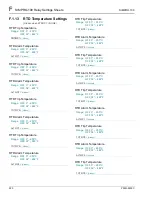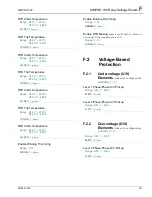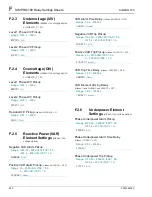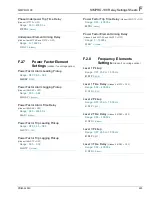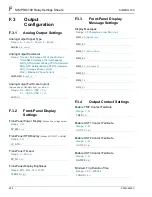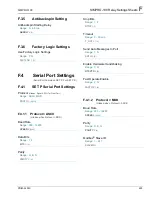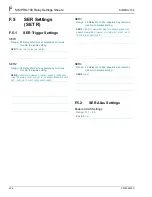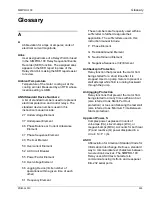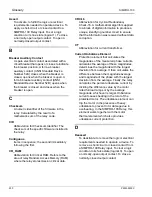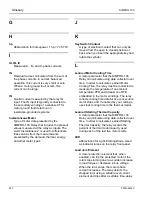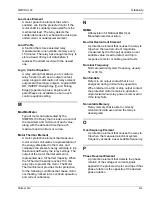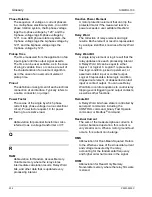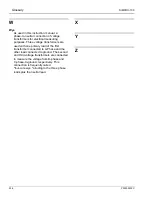
SIMPRO-100
Glossary
PRIM-2400C
233
Load Loss Element
A motor protection element that, when
enabled, can trip the protected motor if the
motor shaft is suddenly decoupled from the
mechanical load. The relay detects the
sudden decrease in mechanical load using an
undercurrent or underpower element.
Load Profile
A function that stores selected relay
measurements in nonvolatile memory every
15 minutes. The relay has enough memory to
store at least 30 days of data before it
replaces the oldest record with the newest
one.
Logic‚ Control Equation
A relay setting that allows you to control a
relay function (such as an output contact)
using a logical combination of relay element
outputs and fixed logic outputs. Logical AND,
OR, INVERT, Rising Edge [/], and Falling
Edge [\] operators, plus a single level of
parentheses are available to use in each
control equation setting.
M
Max/Min Meter
Type of meter data presented by the
SIMPRO-100 Relay that includes a record of
the maximum and minimum of each value,
along with the date and time that each
maximum and minimum occurred.
Motor Thermal Element
A motor protection element that measures
motor current, calculates a representation of
the energy dissipated in the motor, and
compares the present energy estimate to trip
thresholds defined by the relay settings. The
output of the motor thermal element is
represented as a %Thermal Capacity. When
the %Thermal Capacity reaches 100, the
relay trips to protect the motor. The Motor
Thermal Element provides motor protection
for the following conditions that cause motor
overheating: locked rotor, overload operation,
and current unbalance.
N
NEMA
Abbreviation for National Electrical
Manufacturers Association.
Neutral Overcurrent Element
A protection element that causes the relay to
trip when the neutral current magnitude
(measured by the IN input) exceeds a user
settable value. Used to detect and trip in
response to motor or cable ground faults.
Nominal Frequency
Normal electrical system frequency, usually
50 or 60 Hz.
Nonfail-Safe
Refers to an output contact that is not
energized during normal relay operation.
When referred to a trip or stop output contact,
the protected motor remains in operation
unprotected when relay power is removed or
if the relay fails.
Nonvolatile Memory
Relay memory that is able to correctly
maintain its data even when the relay is
deenergized.
O
Overfrequency Element
A protection element that causes the relay to
trip when the measured electrical system
frequency exceeds a user settable frequency.
P
Phase Reversal Element
A protection element that detects the phase
rotation of the voltage or current signals
applied to the protected motor, and trips if that
phase rotation is the opposite of the desired
phase rotation.
Содержание SIMPRO-100
Страница 1: ...SIMPRO 100 Motor Protection Relay Instruction Manual Document No PRIM 2400C ...
Страница 12: ...Contents SIMPRO 100 x PRIM 2400C ...
Страница 16: ...Contents SIMPRO 100 xiv PRIM 2400C ...
Страница 42: ...3 SIMPRO PC Software SIMPRO 100 40 PRIM 2400C ...
Страница 50: ...4 Settings Calculation SIMPRO 100 48 PRIM 2400C Figure 4 2 Generic Thermal Limit Curves Cold Motor ...
Страница 100: ...6 ASCII Serial Port Operation SIMPRO 100 98 PRIM 2400C ...
Страница 127: ...SIMPRO 100 Event Analysis 9 PRIM 2400C 125 Figure 9 2 Example SER Report ...
Страница 136: ...10 Maintenance Troubleshooting SIMPRO 100 134 PRIM 2400C ...
Страница 138: ...A Firmware Versions SIMPRO 100 136 PRIM 2400C ...
Страница 147: ...SIMPRO 100 Control Equations Relay Logic B PRIM 2400C 145 Figure B 3 Display Message Variables ...
Страница 157: ...SIMPRO 100 Control Equations Relay Logic B PRIM 2400C 155 Figure B 16 Overvoltage Element Logic ...
Страница 206: ...D SIMPRO PC Compatibility Features SIMPRO 100 204 PRIM 2400C ...
Страница 214: ...E Motor Thermal Element SIMPRO 100 212 PRIM 2400C ...
Страница 230: ...F SIMPRO 100 Relay Settings Sheets SIMPRO 100 228 PRIM 2400C ...
Страница 239: ......


